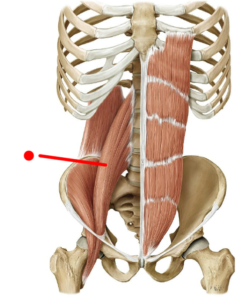For the third time in his past nine tournaments, Tiger Woods withdrew from further play due to back pain.
Woods made it to the green on his 12th hole of the first round at Torrey Pines North Course before withdrawing from the 2015 Farmers Insurance Open.
As reported by CBS Sports, Woods described his difficulty:
“It’s just my glutes are shutting off. Then they don’t activate and then … it goes into my lower back. So, I tried to activate my glutes as best I could, in between, but they just never stayed activated.” [emphasis ours]
Woods also says about the Masters in April:
“The whole idea is to make sure that I’m ready for Augusta, so I got a lot of rounds to play between now and then. That’s what we’re building for…”
Based on how Woods publicly describes his physical condition, ready to compete for The Masters championship he will not be.
Here’s why.
Glutes are your butt muscles. They are a key component of your body’s power center, as they unleash the strength of surrounding muscle. They’re especially important for athletes, because hip extension is a primary source of explosion in many sports, including golf.
To fully understand what Woods is today experiencing, 10 months ago at age 38 Woods had a lumbar microdiscectomy, a surgical procedure of the low back to address a pinched nerve, a source of pain for several months.
With this context, Woods’ explanation of why his glutes would “shut off” and not “activate”, telegraphs that Woods misunderstands the orchestration of his body, according to sports medicine and back pain expert Dr. Sean Wheeler.
Dr. Wheeler, who knows the stresses the sport can place on the body, counts among his former patients Byron Nelson, for whom he served as physician for a brief time during 2005-06.
Dr. Wheeler offers this perspective on Woods’ pain difficulties:
“With Woods, if his gluteus muscles will not fire and contract, there is an unexpected reason for his pain rather than “my glutes won’t activate.”
The likely answer is that his glutes are fatigued, in other words, they are incapable of contracting properly.”
For an iconic athlete as vibrant and physically strong in so many ways as Tiger Woods, how is this possible? After all, Woods hits the gym often for strength training, with an obsession for weightlifting.
Dr. Wheeler explains:
“For Tiger Woods, as with most everyone athlete or no, the answer to solving his pain woe is counterintuitive.
Strength training will NOT improve his recurring low back pain problem.
Instead, based on the pain he describes, Woods should redirect his efforts to circulation training®.
Circulation training, rather than strength training, is needed to improve the endurance of his gluteus muscles, which we label bracing muscles®.”
Why is circulation training necessary, and what is it?
The answer should prompt us all to unlearn what we know—and what we believe—about our bodies and back pain, letting go of our assumptions to learn a new way of thinking about pain, in particular low back pain.
Dr. Wheeler offers a primer revealing the answer:
“Bracing muscles, compared to what we label action muscles®, each perform as their name implies.
Action muscles move—they prompt action—wherever located within your body.
Bracing muscles stabilize—they brace—without moving the body structure they are intended to support whether, for example, your spine, neck, or feet continually throughout the day.
Each of these two types of human muscle offer different performance characteristics requiring different care throughout one’s lifetime.
Action muscles are maintained and, if desired, made even stronger through strength training, by use of movement and resistance.
In contrast, as bracing muscles provide all-day stabilization, they require the constant flow of energy achieved through blood flow. Maintaining this blood flow to the low back and gluteus bracing muscles, through circulation training, becomes ever more important as these muscles must maintain their endurance—and bracing capability—as blood flow naturally begins to decrease to our spinal discs as we age, typically in our mid-30s.
The differences come into sharp relief:
“Strength training is about pumping iron and building muscle mass for action muscle power.
Circulation training is about pumping blood for bracing muscle endurance.”
Every human being needs both strength training and circulation training for a healthy, sustained life.
Yet, in today’s medicine, too often circulation training is overlooked and the obvious benefits not embraced—by physicians, health insurance carriers, and patients.
Bracing muscle endurance is the single most important key to achieving freedom from back pain, pointing to the counterintuitive answer of how Tiger Woods can be liberated from his chronic low back pain:
Rather than strength, Woods must build endurance in his bracing muscles—those of his low back and his glutes.
For the lumbar spine and gluteus bracing muscles to contract—and brace—they must possess ample endurance.
The importance of the gluteus bracing muscles is that they stabilize the hip. If these muscles fatigue, the hip is unstable.

IF these bracing muscles lack endurance, action muscles spring into—what else?—action, to compensate for non-performing gluteus and low back bracing muscles. As Woods’ nearby action muscles—in this instance psoas [soh-uh s] muscles—are likely very strong given his strength training habits, these psoas action muscles attempt to compensate for his lethargic bracing muscles.
Psoas action muscles cross the hip joint, on both sides left and right, and attach to the lumbar/low back region of the spine. Because of where the psoas attach to the low back, when forced to compensate for weakened bracing muscles, psoas action muscles can go into spasm and cause back pain.
Says Dr. Wheeler:
“If the psoas action muscle spasm, the bracing gluteus is unable to contract, as the two muscles compete. The result creates an inescapable, repeating cycle similar to traversing the impossible Penrose stairway; one may ascend or descend the stairs forever yet end up back at the same spot every time.
Fatigued gluteus bracing muscles cause psoas action muscles to spasm which cause the gluteus not to contract, leading to less endurance of the gluteus bracing muscles, repeating the cycle.
Without breaking the cycle, the consequence is sustained low back pain.”
But again we are talking Tiger Woods, he with access to the world’s best strength training equipment and trainers. Why would his psoas action muscles be forced to compensate for his low back and gluteus bracing muscles?
There could be many reasons, but the most likely is Woods’ back surgery of 10 months ago at age 38.
Woods seeming propensity to focus on strength training benefits his action muscles, yet without sufficient post-operative, restorative circulation training as he ages, Woods’ bracing muscles are likely unable to properly perform.
Once one loses endurance in the bracing muscles of the low back, a 180 in 180® is required—a 180 degree refocus in how to care for your back—requiring 180 days to unlearn what you think you know about your body and low back pain, and to develop the good habits needed to restore bracing muscle endurance.
Woods must give himself adequate time which, depending upon his schedule and focus, could be as much as 180 days to restore his low back and gluteus bracing muscle endurance.
Knowing what he means to the world of golf, we trust Woods returns to form soon, after his low back and gluteus bracing muscle endurance is restored.

